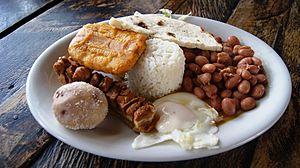Colombian cuisine facts for kids
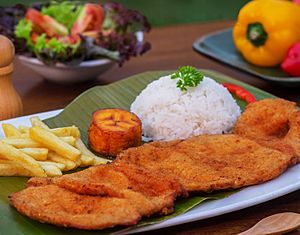
Colombian cuisine is a mix of food traditions from Colombia's six main regions: Pacific, Amazon, Andes, Orinoco, Caribbean, and Insular. Colombian food changes a lot depending on where you are. It's mostly shaped by native Colombian, Spanish, and African cooking styles. Some areas also have a little Arab influence. Colombia is one of the most biodiverse countries, meaning it has a huge variety of ingredients available in different regions.
Contents
The Story of Colombian Food
Colombian food is a special blend of native and European traditions, with a strong touch of Afro-Caribbean flavors. Before Europeans arrived, two big native groups were the Tairona (living on the Caribbean coast) and the Muisca (living in the highlands). One of the oldest Colombian dishes is arepas, made from ground corn. People believe the name arepa comes from a word for corn in the Chibcha languages.
Popular Colombian Dishes
Colombia has many delicious foods! Here are some of the most famous:
Snacks and Appetizers
- Patacones: These are green plantains that are fried, squished flat, and then fried again until crispy.
- Buñuelos: Deep-fried dough balls, often enjoyed around Christmas.
- Pandebono: A yummy cheese bread made with yucca flour.
- Arepas: These are corn cakes, a staple in Colombia. You can eat them plain or with fillings.
- Aborrajados: Fried sweet plantains filled with cheese.
- Empanadas: Small fried pastries usually filled with shredded meat, potatoes, or cheese.
- Almojábanas: Small cheese buns made with corn flour.
Main Meals
- Bandeja paisa: This is a huge, traditional dish from the Antioquia region. It comes with beans, rice, ground meat, a sausage called chorizo, a fried egg, arepa, and crispy pork belly (chicharrón). It's often served with avocado and special sauces.
- Lechona tolimense: A whole roasted pig stuffed with yellow peas and pork meat.
- Tamales: These are corn or corn/rice "cakes" wrapped in plantain leaves and steamed. They can be filled with chicken, potatoes, peas, carrots, and rice. Each region has its own special way of making them!
- Fish Dishes: Especially popular on the coast, like arroz de lisa (lisa fish rice).
- Fritanga: A popular dish with different meats, fried plantains, crispy pork rinds (chicharrones), and yellow potatoes. It's often served with ají sauce.
- Frijolada: A hearty dish made with pinto or red beans, often cooked with diced pork, carrots, corn, and sometimes bacon. It's usually served with rice and avocado.
Soups
- Sancocho: A popular soup that mixes vegetables and chicken or fish. It usually has yucca, corn, and is often eaten with banana slices.
- Ajiaco: A traditional soup from Bogotá. It's made with chicken and different kinds of potatoes, flavored with a local herb called "guasca."
- Changua: A milk soup with eggs, often eaten for breakfast in the central Andes region.
- Caldo de costilla: (Rib broth) A warm soup made with beef ribs, potatoes, garlic, onion, and cilantro leaves.
- Mondongo: A very filling soup with diced tripe (part of a cow's stomach) and lots of vegetables like peas, carrots, onions, and potatoes.
Desserts and Sweets
- Natillas: A Colombian version of custard, made with milk, cornstarch, and spices, but no eggs.
- Bocadillo: A sweet guava jelly, often eaten with cheese.
- Cocadas: Sweet coconut balls.
- Obleas: Thin wafers often filled with arequipe (milk caramel) or fruit jams.
- Tres leches cake: A sponge cake soaked in three types of milk.
- Milhoja: A dessert similar to a Napoleon, with many layers of pastry and cream.
- Arequipe: Colombia's version of milk caramel, used in many desserts.
- Arroz con leche: Sweetened rice cooked with milk.
Sauces
- Hogao: A tasty tomato and onion sauce.
- Ají: A spicy sauce made with cilantro, used to add flavor to many dishes.
Regional Food Specialties
Colombia's food changes a lot from one region to another because of different climates and traditions.
- Medellín: The most famous dish is the bandeja paisa, a very large meal with many different ingredients.
- Cali: The traditional dish is "sancocho de gallina" (chicken soup). Cali is also known for its empanadas, pandebono, and aborrajados.
- Bogotá and the Andes: Ajiaco is the traditional dish here, a chicken and potato soup.
- Caribbean Coast: You'll find spicy dishes with fish and lobster. Coconut rice is very common. This area also has some Arab-influenced dishes like Kibbeh.
- Llanos (Plains): Barbecued meats, like "ternera llanera" (grilled veal), and river fish are popular.
- Amazonas: The food here is influenced by Brazilian and Peruvian traditions.
- Inland Areas: Dishes mix native and European cooking. They use local farm products, cattle, and river fish. Examples include sancocho in Valledupar and arepas.
- Nariño: A traditional dish is broiled guinea pig (cuy asado), influenced by Inca cooking.
- Tolima: The Tamales Tolimenses are a special treat. These tamales are made of corn dough and filled with peas, carrots, potatoes, rice, chicken, pork, and spices.
- San Andres, Providencia, and Santa Catalina Islands: The main dish is rondon, a seafood stew made with coconut milk, fish, conch, yucca root, sweet potato, and pumpkin. They also have a delicious crab soup.
Fruits of Colombia
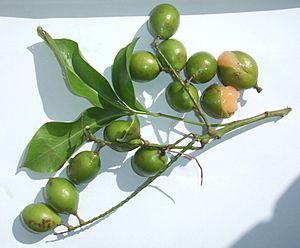
Colombia is a tropical country, so it grows a huge variety of fruits! You'll find fruit and juice stands everywhere, especially on the Caribbean coast.
- Some common fruits are bananas, mangoes, oranges, passion fruit (maracuyá), Cape gooseberry (uchuva), and strawberries.
- Colombia also has many unique fruits you might not find elsewhere, like:
* Lulo (Naranjilla): A tangy, orange-like fruit often used in juices. * Borojó: A dark, strong-flavored fruit. * Curuba: A long, yellow passion fruit. * Mamoncillo (Spanish lime): Small, sweet-sour green fruits. * Guanábana: A large, green, spiky fruit with sweet, white flesh. * Tree tomato (tomate de árbol): A fruit that looks like a tomato but tastes different.
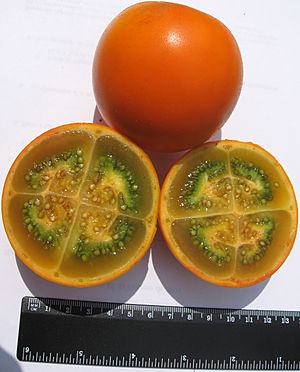
Drinks of Colombia
Colombians love fruit juices! They drink more than three-quarters of a serving of juice every day.
- Aguapanela: Made by dissolving panela (a type of raw sugar cane block) in water. It can be served hot or cold. When hot, people often add cheese to melt in it!
- Champús: A thick drink made from corn, pineapple, lulo, and other ingredients.
- Hot chocolate: Colombian hot chocolate is made with milk, water, and semi-sweet chocolate bars. It's often flavored with cinnamon, cloves, and vanilla. People use a special pitcher (chocolatera) and a wooden whisk (molinillo) to make it frothy.
- Colombian coffee: Famous worldwide for its quality. Many Colombians drink it as a "tinto" (black with sugar) or "café con leche" (half coffee, half hot milk).
- Colombiana: A popular kola champagne soda.
- Lulada: A refreshing drink from Cali, made from lulo fruit. It has a smoothie-like texture.
- Malta: A carbonated, non-alcoholic malt drink.
- Postobón: A brand of sodas with many flavors, apple being the most popular.
- Salpicón: A fruit cocktail drink, often made with diced fruit and soda.
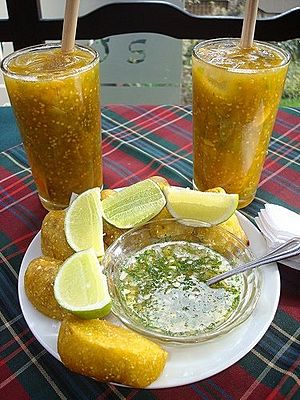
Images for kids
-
Fried Red Snapper, fried plantain, rice and tomato.
-
rice atollao
-
A caldo de costilla served hot and with cilantro leaves.
-
Patacones are twice-fried plantain patties, often served as a side, appetizer, or snack. Here they are being fried for the second time.
-
A traditional breakfast of Bogotá: hot chocolate with cheese, almojábanas and pan de queso.
-
empanada barranquillera.
-
Bocadillo with leaf packaging.
-
Colombian coffee is known for its quality and distinct flavor.
See also
 In Spanish: Gastronomía de Colombia para niños
In Spanish: Gastronomía de Colombia para niños


